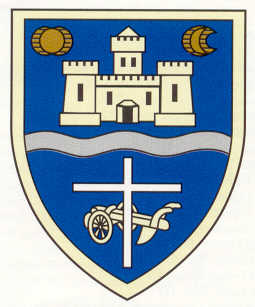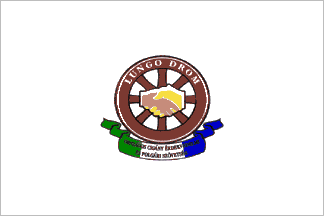
image by Ivan Marinov, 15 March 2001

Last modified: 2006-04-08 by dov gutterman
Keywords: hungary | bunjevatses | germany | croatia | slovakia | romania | serbia | slovenia | greece | ukraine | poland | armenia | ruthenia | gipsies | wends | vends |
Links: FOTW homepage |
search |
disclaimer and copyright |
write us |
mirrors
See also:
The 13 Official Ethnic Minorities of Hungary are:
- Germans
- Slovaks : 25.000 - 100.000 in the Northern
Mountains and Békés County
- Romanians : 15.000 in some village near the Romanian border
- Croats
- Serbs : 5.000 in South Hungary
- Slovenians : 5.000 some village near Szentgotthárd, Vas County (see: Wends)
- Bulgarians
- Greeks: in Beloiannis village
- Gipsies : 500.000 - 1.000.000 all over the
country
- Ruthenians
- Ukrainian
- Armenian
- Polish
The minorities use their ethnic/country flags
István Molnár, 13 June 2000
Ethnic flags of the thirteen ethnic minorities of Hungary on a
square of Budapest XVIII at <www.etnonet.hu>
You can see the following flags:
- Budapest XVIII
- Hungary
- Slovenian
- Gipsy
- German minority in Hungary
- Ruthenian (with Coat of Arms)
- Armanian
- Polish
István Molnár, 2 October 2001

image by Ivan Marinov, 15 March 2001
First Bulgarians came to Hungary in the 17th century, to the
Banat region, now divided between Yugoslavia and Romania. They
were Catholic Bulgarians, and developed a new literary version of
Bulgarian, written with Latin letters. Now, they are still a few
thousands of people in the Romanian part of Banar, who still
speak Bulgarian. The greatest wave of Bulgarian emigration to
Hungary was at the end of the 19th century and in the first half
of the 20th century. Interestingly, 95 % of them came from the
Veliko Tarnovo region in the northern part of Bulgaria. Most of
them are from two villages in Bulgaria: Draganovo and
Polikraishte. The total number of emigrants was 7,000. Now, we
have 30-35 thousands of people in Hungary of Bulgarian origin.
The major part of them are totally asimilated, and consider
themselves only Hungarians. There are only 7-8 thousands people
who consider themselves Bulgarians, most of them consider
themselves of dual identity, Bulgarian and Hungarian at the same
time. Most Bulgarians in Hungary speak better Hungarian, than
Bulgarian language.
In the meetings generally three flags are used, the Bulgarian
flag, the Hungarian flag with the coat of arms, and the flag of
the Union of Bulgarians in Hungary (above) , a cultural
organization. The image has not the very best quality, it was
made by me, and the central part was scanned from my own
membership card.
The number (1914) means the date when the Union was formed. And
the stylized tree means the main profession of the Bulgarian
emigrants in the past: gardening.
Ivan Marinov, 15 March 2001
Bunjevatses (Croatophon people in Hungary, Serbia and Rumania)
Bunjevci in Croatian (one would read that approximately as
Boonyevtzi). As far as I know, they consider themselves
Croatians, and use Croatian flag (or variation without the
"crest" and smaller shield often in home made flags).
Jaume Ollé and Željko Heimer , 31 July 1999
As far as I know, they consider themselves Croatians, and use
Croatian flag (or variation without the "crest" and
smaller shield often in home made flags), though they may be some
local flags. However, such flags would not be the national flags,
but the flags of their societies and such. I believe
Željko Heimer 31 July 1999
Croats: 50.000 in West Hungary and near the Hungarian-Croatian
border.
István Molnár, 13 June 2000
Today in Hungary Croats have got 5 territorial-ethnical
groups. One of them are Bunjevatses (with
reach traditions). All the groups use the Croatian tricolour
István Molnár, 12 December 2000
Gradiste is not only the territory in Burgenland. Some
villages of Gradiste is in Hungary (Narda, Szentp?terfa-Petrovo
Selo etc.). Gradiste is the territory in the formerly
West-Hungary (larger part is nowaday Burgenland). Croats settled
to this territory (from Bratislava to Nagykanizsa) in the 16-17th
centuries. You can find Croatian inhabited villages near
Bratislava and in Hungary: Bezenye-Bizonja, Kimle etc.
István Molnár, 13 January 2001
The website for Croats in Hungary (<www.croatica.hu>) shows the
flag for the Republic of Croatia as opposed to a modified flag.
Marko Puljic, 5 June 2001
Horvátlövo is Croatian village in the Vas County, that
borders Austria. The Croatian name for the village is Hrvatske
Sice.
Marko Puljic, 8 Febuary 2002

image by István Molnár, 28 November 2000

Vertical Flag
image by Jens Pattke, 29 July 2001 (based on photo by István
Molnár)

Coat of Arms
image by István Molnár, 13 June 2000
The coat of arms of the association of the Germans from
Hungary is: "divided per fess azure, argent and or, with a
village and a cannon sable on the middle fess. On the whole a
latin cross argent fimbriated sable".
Pascal Vagnat, 1 August 1999
Germans : 200.000 - 400.000 in West-Hungary, Baranya and Tolna
Counties and many villages in the mountains. Above is the Coat of
Arms of the German Ethnic Minority of Hungary. The minority uses
its country flag (the black-red-yellow).
István Molnár, 13 June 2000
The German minority in Hungary prior to and during WW2 used
this flag: White flag with a yellow "sun wheel
swastika" enclosed by a red circle.
Source: David Littlejohn - Foreign Legions of the Third
Reich
Marcus Wendel, 20 September 2000
I was in Béb in the morning and I saw a small flag on a table
in the Office of the Community. This little flag shows the flag
of the German Minority in Hungary. In summer I saw a
black-and-white photo of this flag. I made two images based on
these informations. A vertical and a horizontal one.
István Molnár, 28 November 2000
See also:
Gipsies : 500.000 - 1.000.000 all over the country. The
Gipsies of Hungary haven't got own flag, they used the Gipsy flag
From Kata Fris, writer of the Amaro Drom (Gipsy periodical
review):
the blue shows the sky,
the white shows the grass
and the red cart-wheel shows the wandering
István Molnár, 13 June 2000
I wanted to report on a flag seen in my recent trip to
Budapest. On a hose that was a kind of Rom cultural center (or
school maybe) was hoisted together with the Hungarian tricolour a
Rom flag that was in one point distinctive to the
"usual" Rom flag - namely it was defaced with a yellow
thin diagonal stripe. I.e. the flag was light blue over green
bicolour with red wheel in the middle and overall a thin golden
diagonal strupe from base hoist rising to top fly.
I guess that this is the particular flag of the group or
organziation to which the house bellongs. If I have noticed it
rightly, it seems that the numerous groups of Roms in Europe (and
elsewhere?) use slightly differentiated flags, but on the other
hand, it seems that they all recognize the same basic design and
the differenciations are either due to non-existance of the
unified authority that would prescribe the flag, or to the wish
(and need) to express bolonging to a particular organization and
not to the nation as a whole only.
Željko Heimer, 2 June 2001
Photo of Hungarian Gipsy flag at <www.romaweb.hu>.
István Molnár, 30 March 2006

image by István Molnár, 21 May 2003
Lungo Drom Országos Cigány Érdekvédelmi és Polgári
Szövetség (Lungo Drom Nationwide Gipsy Community of Interest
and Civic Federation). Lungo Drom means Hosszú Út in Hungarian
and Long Drive in English.
The largest gipsy organisation in Hungary. The federation has got
3 members in the parliament and many representatives in the local
and ethnic councils. The organisation was in coalition with the
Fidesz-MPP on the last election.
Source: Symbol and the description of the flag from the
Lungo Drom.
István Molnár, 21 May 2003
See also: Hungary - Political Flags
greek.gif)
image from <www.c3.hu/~szegmens>,
located by István Molnár
This is the symbol of the Greek Ethnic Council in Szeged only.
It has got a part of the Szeged's Coat of Arms.
István Molnár, 18 March 2001

image by István Molnár, 15 June 2000
The Ruthenians of Hungary haven't got own flag but they used
the Ruthenian flag of the Ruthenians of the World
(Transcarpathia, Slovakia, Hungary and the USA). I got this
information from Mrs Jozsefne Csepanyi-Bardos, the president of
the Ruhenian Ethnic Minority Council in Budapest Capital.
The Ruthenians are the settlers of Transcarpathia,
and they are the majority there.
István Molnár, 15 June 2000
The President of the Ethnic Council of the Ruthenians in
Budapest wrote me: "This flag is used by all Ruthenians of
the World. She also wrote me: "Ruthenians are not
Ukrainians!". In Hungary the Ruthenians have own Ethnic
Council and the Ucrainians have another . The Ucrainians use the
UA flag.
István Molnár, 21 September 2000
The Homepage of the Ruthenian Minority Autonomy of The Capital
is at <www.ruthen.hu>.
István Molnár, 11 March 2001
Here is the Coat of Arms of the Ruthenians from <www.comp-press.hu>
. This Coat of Arms has some resemblance to the Transcarpathian
Coat of Arms.
István Molnár, 15 June 2000
slovk.gif)
image from <www.c3.hu/~szegmens>,
located by István Molnár
This is the symbol of the Slovakian Ethnic Council in Szeged
only. It has got a part of the Szeged's Coat of Arms.
István Molnár, 18 March 2001
Symbol of the Slovak Ethnic Minority Council of
Tatabanya-Banhida can be seen at <www.kembridge.hu>.
István Molnár, 2 March 2003
Coat of Arms of National Self-Government of Slovaks in Hungary
is at <www.slovaknet.hu>.
István Molnár, 25 September 2003
Wends: Slovenian ethnic groups in West Hungary and the
neighbouring (former Hungarian) territories in Slovenia. The name
"vend" is used by Hungarians and some of the wends.
In the Hungarian censuses:
1850-1910: Vends means Slovenians
1920-1941: Vends or Slovenians
1948-1980: Yugoslavians (Croatians, Serbs, Slovenians)
1990: Slovenians or Vends
Vends in this region are for some generations already.
István Molnár, 19 September 2000
See also: Sorb People (Germany)